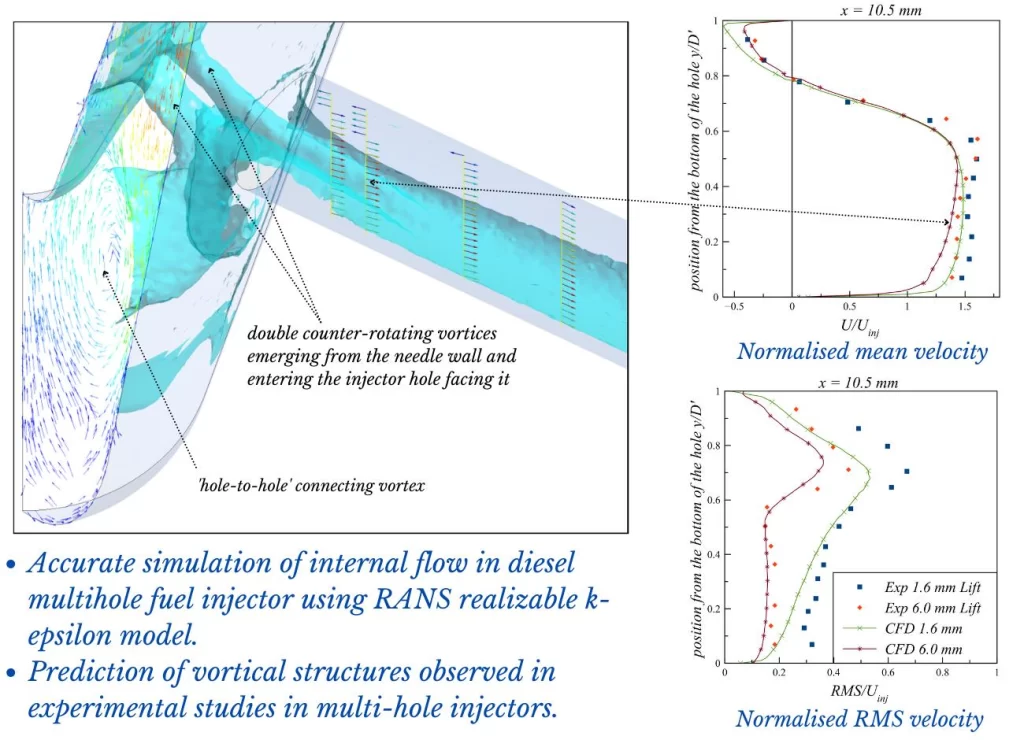Publications
This study assessed two cavitation models for compressible cavitating flows within a single hole nozzle. The models evaluated were SS (Schnerr and Sauer) and ZGB (Zwart-Gerber-Belamri) using realizable k-epsilon turbulent model, which was found to be the most appropriate model to use for this flow. The liquid compressibility was modeled using the Tait equation, and the vapor compressibility was modeled using the ideal gas law. Compressible flow simulation results showed that the SS model failed to capture the flow physics with a weak agreement with experimental data, while the ZGB model predicted the flow much better. Modeling vapor compressibility improved the distribution of the cavitating vapor across the nozzle with an increase in vapor volume compared to that of the incompressible assumption, particularly in the core region which resulted in a much better quantitative and qualitative agreement with the experimental data. The results also showed the prediction of a normal shockwave downstream of the cavitation region where the local flow transforms from supersonic to subsonic because of an increase in the local pressure.
This study assesses the predictive capability of the ZGB (Zwart-Gerber-Belamri) cavitation model with the RANS (Reynolds Averaged Navier-Stokes), the realizable k-epsilon turbulence model, and compressibility of gas/liquid models for cavitation simulation in a multi-hole fuel injector at different cavitation numbers (CN) for diesel and biodiesel fuels. The prediction results were assessed quantitatively by comparison of predicted velocity profiles with those of measured LDV (Laser Doppler Velocimetry) data. Subsequently, predictions were assessed qualitatively by visual comparison of the predicted void fraction with experimental CCD (Charged Couple Device) recorded images. Both comparisons showed that the model could predict fluid behavior in such a condition with a high level of confidence. Additionally, flow field analysis of numerical results showed the formation of vortices in the injector sac volume. The analysis showed two main types of vortex structures formed. The first kind appeared connecting two adjacent holes and is known as “hole-to-hole” connecting vortices. The second type structure appeared as double “counter-rotating” vortices emerging from the needle wall and entering the injector hole facing it. The use of RANS proved to save significant computational cost and time in predicting the cavitating flow with good accuracy.
The occurrence of vortices in the sac volume of automotive multi-hole fuel injectors plays an important role in the development of vortex cavitation, which directly influences the flow structure and emerging sprays that, in turn, influence the engine performance and emissions. In this study, the RANS-based turbulence modelling approach was used to predict the internal flow in a vertical axis-symmetrical multi-hole (6) diesel fuel injector under non-cavitating conditions. The project aimed to predict the aforementioned vortical structures accurately at two different needle lifts in order to form a correct opinion about their occurrence. The accuracy of the simulations was assessed by comparing the predicted mean axial velocity and RMS velocity of LDV measurements, which showed good agreement. The flow field analysis predicted a complex, 3D, vortical flow structure with the presence of different types of vortices in the sac volume and the nozzle hole. Two main types of vortex were detected: the “hole-to-hole” connecting vortex, and double “counter-rotating” vortices emerging from the needle wall and entering the injector hole facing it. Different flow patterns in the rotational direction of the “hole-to-hole” vortices have been observed at the low needle lift (anticlockwise) and full needle lift (clockwise), due to their different flow passages in the sac, causing a much higher momentum inflow at the lower lift with its much narrower flow passage.
The present study assesses RANS-based turbulence models to simulate the isothermal confined swirling flow in a combustor representing a constituent can combustor of the can-annular configuration used in jet engines. The two-equation models (standard k-epsilon𝑘−𝜖, realizable k-epsilon𝑘−𝜖 𝑘−𝜖, standard k-omega𝑘−𝜔k-omega, SST k-omega 𝑘−𝜔), and the seven-equation model (linear pressure strain-Reynolds stress model, LPS-RSM), are assessed by comparing their predictions of mean axial velocity, mean transverse velocity, turbulent kinetic energy, and shear stress with the experimental data at two different positions (i.e., the primary and dilution hole planes) in the combustor. While the two-equation models generally have failed to predict the confined swirling flow at both positions accurately, the SST k-omega𝑘−𝜔 model yielded the most accurate, followed by the standard 𝑘−𝜔 k-omega and realizable 𝑘−𝜖 k-omega models. The discrepancies between the computational and experimental results could be attributed to the isotropic turbulence assumptions, which are invalid for confined swirling flows. Further, the two-equation model formulations cannot capture the intricacies of vortex flow and its interaction with the surroundings in confined swirling flows. The LPS-RSM, which considers turbulence anisotropy, showed some promise, although overpredicted results follow the trend with experimental values at the primary holes plane. However, at the dilution holes plane, the model overpredicted the velocity field and underestimated the turbulence field, including turbulent kinetic energy and shear stress. These observed discrepancies can be ascribed to the pressure-strain correlation in the LPS-RSM, which assumes the pressure is a linear function of the strain-rate tensor. However, this linear assumption is quite simplistic for complex flows. Further, the influence of discretization (SOU and third-order MUSCL) schemes of convective terms is also assessed, and the differences in predictions resulted from the MUSCL scheme having lower diffusion and superior ability to capture sharper gradients, however, did not translate into improving the solution accuracy. Hence, this study suggests that more advanced high-fidelity turbulence models (e.g., hybrid RANS-LES, LES, DNS) are needed to predict the confined swirling flow in combustors accurately.




